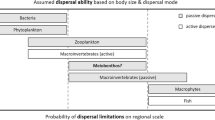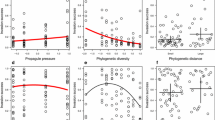Summary
One hundred communities were developed through the controlled introductions of microorganisms to beakers over a six month period of time. Following three months of development, a series of three separate previously unencountered species were introduced into each community. The persistences of these invaders were monitored and their relationships to invaded community complexity, composition and history of development evaluated. The null hypothesis that colonization success is independent of community complexity cannot be rejected. The rate at which species were introduced during development of these communities, as well as beaker size, influenced the invasion success of Dictyosphaerium, but not Staurastrum or Platydorina. The assembled communities were of two types: those dominated by Ochromonas and those domnated by Paramecium bursaria. Ochromonas dominated communities were invulnerable to the invasion of the above 3 species; no clear pattern of invulnerability was evident for P. bursaria communities.
Similar content being viewed by others
References
Baumol WJ (1965) Economic Theory and Operations Analysis. Prentice-Hall, Englewood Cliffs, NJ, p 606
Bold HC, Wynne MJ (1978) Introduction to the algae: structure and reproduction. Prentice Hall, Englewood Cliffs, NJ p 706
Cairns J, Dahlberg ML, Dickson KL, Smith N, Waller WT (1969) The relationship of freshwater protozoan communities to the MacArthur-Wilson equilibrium model. Am Nat 103:439–454
Caswell H (1976) Community structure: a neutral model analysis. Ecol Monogr 46:327–354
Colwell RK, Winkler DW (In press) tA null model for null models in biogeography. In: Strong DR, Simberloff D, Abele L (eds) Ecological communities: conceptual issues and evidence. Princeton Univ Press: Princeton, NJ
Connell JH (1975) Some mechanisms producing structure in natural communities. In: Cody ML, Diamond JM (eds) Ecology and evolution of communities. Belknap Press of Harvard University Press, Cambridge, MA pp 460–490
Connor EF, Simberloff D (1978) Species number and compositional similarity of the Galapagos flora and avifauna. Ecol Monogr 48:219–248
Crowell KL (1973) Experimental zoogeography: introduction of mice to small islands. Am Nat 107:535–558
Crowell KL, Pimm SL (1976) Competition and niche shifts of mice introduced onto small islands. Oikos 27:251–258
DeBach P (1964) Successes, trends and future possibilities. In: DeBach P, Schlinger EI (eds) Biological control of insect pests and weeds. Reinhold, NY pp 673–713
DeBach P (1965) Some biological and ecological phenomena associated with colonizing entomophagous insects. In: Baker HG, Stebbins GL (eds) The Genetics of Colonizing Species. Academic Press, NY pp 287–303
DeBach P (1974) Biological Control by Natural Enemies. Cambridge University Press, NY p 325
Diamond JM (1975) Assembly of species communities. In: Cody ML, Diamond JM (eds) Ecology and evolution of communities. Belknap Press of Harvard University Press, Cambridge, MA pp 342–444
Diamond JM, Marshall AG (1977) Distributional ecology of New Hebridean birds: A species kaleidoscope. J Anim Ecol 46:703–727
Elton CS (1958) The ecology of invasions by animals and plants. Chapman and Hall, London, p 181
Gilbert FS (1980) The equilibrium theory of island biogeography: fact or fiction? J Biogeogr 7:209–235
Heck KL (1976) Some critical considerations of the theory of species packing. Evol Theory 1:247–258
Hillier FS, Lieberman GJ (1967) Introduction to Operations Research. Holden Day, San Francisco, p 639
Horn HS (1975) Markovian properties of forest succession. In: Cody ML, Diamond JM (eds) Ecology and Evolution of Communities. Belknap Press, Cambridge, Mass pp 196–211
Levins R, Heatwole H (1973) Biogeography of the Puerto Rican bank: introduction of species onto Palominitos Island. Ecology 54:1056–1064
MacArthur RH (1972) Geographical ecology. Harper and Row, New York, pp 269
MacArthur RH, Levins R (1967) The limiting similarity, convergence, and divergence of coexisting species. Am Nat 101:377–385
MacArthur RH, Wilson EO (1967) The theory of island biogeography. Princeton Univ Press, Princeton, NJ p 202
Maguire B (1973) Niche response structure and the analytical potentials of its relationship to habitat. Amer Nat 107:213–246
May RM (1973) Stability and complexity in model ecosystems. Princeton University Press, Princeton, pp 265
May RM (1974) On the theory of niche overlap. Theor Pop Biol 5:297–332
May RM (1975) Patterns of species abundance and diversity. In: Cody ML, Diamond JM (eds) Ecology and evolution of communities. Belknap Press of Harvard University Press, Cambridge, MA, pp 81–120
May RM, MacArthur RH (1972) Niche overlap as a function of environmental variability. Proc Nat Acad, Sci USA 69:1109–1113
McNab BK (1971) The structure of tropical bat faunas. Ecology 52:352–358
Muller WA, Lee JJ (1977) Biological interactions and the realized niche of Euplotes vammus from the salt marsh aufwuchs. J Protozool 24:523–527
Nevo E, Gorman G, Soule M, Yung Yang S, Clover R, Jovanovic V (1972) Competitive exclusion between two insular Lacerta species. Oecol (Berlin) 10:183–190
Nichols HW (1973) Growth media-freshwater. In: Stein R (ed) Handbook of phycological methods. Cambridge University Press, Cambridge, UK pp 7–24
Paine RT (1966) Food web complexity and species diversity. Am Nat 100:65–75
Power DM (1975) Similarity among the avifaunas of the Galapagos Islands. Ecology 56:616–626
Radovanović M (1956) Rassenbildung bei den Eidechsen auf Adriatischen Inseln. Usterr/Akad Wiss 110:1–82
Radovanović M (1959) Zum Problem der Speziation bei Inseleidechsen. Zool Jahrb Abt System Okol u Geogr 86:395–436
Radovanović M (1960) Die Bedeutung der Verschleppung in der Ausbreitung der Inseleidechsen. Zool Anz Suppl 23:501–506
Richter-Dyn N, Goel NS (1972) On the extinction of a colonizing species. Theor Pop Biol 3:406–433
Richter-Dyn N, Goel NS (1974) Stochastic Models in Biology. Academic Press, New York
Robinson JV (1981) An assortative model of island biogeography. J Social Biol Struct 4:7–18
Robinson JV, Ladde GS (1982) Feasibility constraints on the elastic expansion of ecosystem models. J theor Biol 97:277–287
Robinson JV, Valentine WD (1979) The concepts of elasticity, invulnerability, and invadability. J theor Biol 81:91–104
Roughgarden J (1974) Species packing and the competition function with illustrations from coral reef fish. Theoretical Population Biology 5:163–186
Roughgarden J (1979) Theory of population genetics and evolutionary ecology: an introduction. MacMillan, New York, p 634
Simberloff DS (1978) Using island biogeographic distributions to determine if colonization is stochastic. Am Nat 112:713–726
Sutherland JP (1974) Multiple stable points in natural communities. Am Nat 108:859–873
Tilman D (1980) Resources: a graphical-mechanistic approach to competition and predation. Am Nat 116:362–393
Turelli M (1981) Niche overlap and invasion of competitors in random environments. I. Models without demographic stochasticity. Theor Pop Biol 20:1–56
Whittaker RH (1970) Biochemical ecology of higher plants. In: Sondheimer E, Simeone JB (eds) Chemical Ecology, New York, pp 43–66
Author information
Authors and Affiliations
Rights and permissions
About this article
Cite this article
robinson, J.V., Dickerson, J.E. Testing the invulnerability of laboratory island communities to invasion. Oecologia 61, 169–174 (1984). https://doi.org/10.1007/BF00396755
Received:
Issue Date:
DOI: https://doi.org/10.1007/BF00396755




